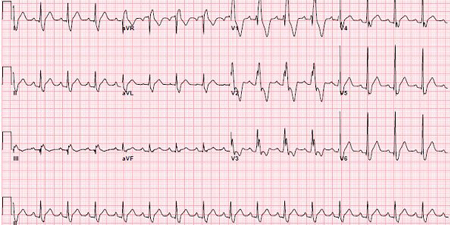Transient ST Elevations and Conduction Delay After Traumatic Fracture of the Sternum
A 25-year-old man with no significant medical history was attempting to move a heavy container when he lost control and became pinned between the container and a concrete pole.
A 25-year-old man with no significant medical history was attempting to move a heavy container when he lost control and became pinned between the container and a concrete pole. He was brought to the emergency department complaining of chest pain.
Trauma protocol imaging revealed a nondisplaced sternal fracture. An electrocardiogram (Figure 1) showed ST segment elevation in lateral leads, with a right bundle branch block (RBBB). Cardiac enzymes levels were normal.
Figure 1

Chest pain resolved with NSAID administration. A follow-up ECG done 16 hours later showed resolution of ST elevations and the bundle branch block (Figure 2). Echocardiography showed no wall motion abnormality, and a normal ejection fraction and no pericardial effusion. The patient was discharged home to follow-up with his primary care physician.
Figure 2

Myocardial contusion occurs in 8.2% to 75% of trauma patients. It is more commonly reported in association with fracture of the sternum than with other injuries.1 Diagnostic criteria for myocardial contusion vary and may include any or a combination of the following:1,2
• New ECG changes, such as arrhythmias, ST-segment and T wave changes, and RBBB
• Elevated cardiac enzyme levels and wall motion abnormality detected on echocardiography
Blunt cardiac and thoracic trauma are associated with a 3-fold increase in the risk for cardiac conduction abnormalities-especially RBBB. This increased risk is thought to be the result of the anatomical proximity of the right ventricle to the sternum, which makes it more vulnerable to injuries directed at the sternum.3
A favorable outcome is reported in patients with myocardial contusion; in one study most abnormal echocardiographic findings resolved.2 However, there are no data regarding the outcome of patients in whom only conduction abnormalities developed following trauma.
References:
REFERENCES:1. Boeken U, Feindt P, Gramsch-Zabel H, et al. The incidence of myocardial contusion in 160 patients with blunt chest trauma. Eur J Trauma. 2000;26:111-115.
2. Lindsteadt M, Germing A, Lawo T, et al. Acute and long-term clinical significance of myocardial contusion following blunt thoracic trauma: results of a prospective study. J Trauma. 2002;52:479-485.
3. Ismailov RM. Trauma associated with cardiac conduction abnormalities: population-based prospective mechanism and review of the literature. Eur J Trauma Emerg Surg. 2010;36:227-232.